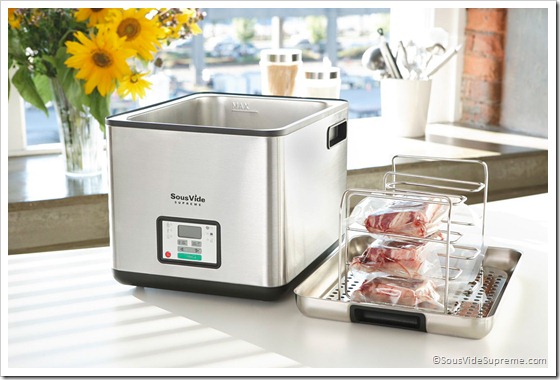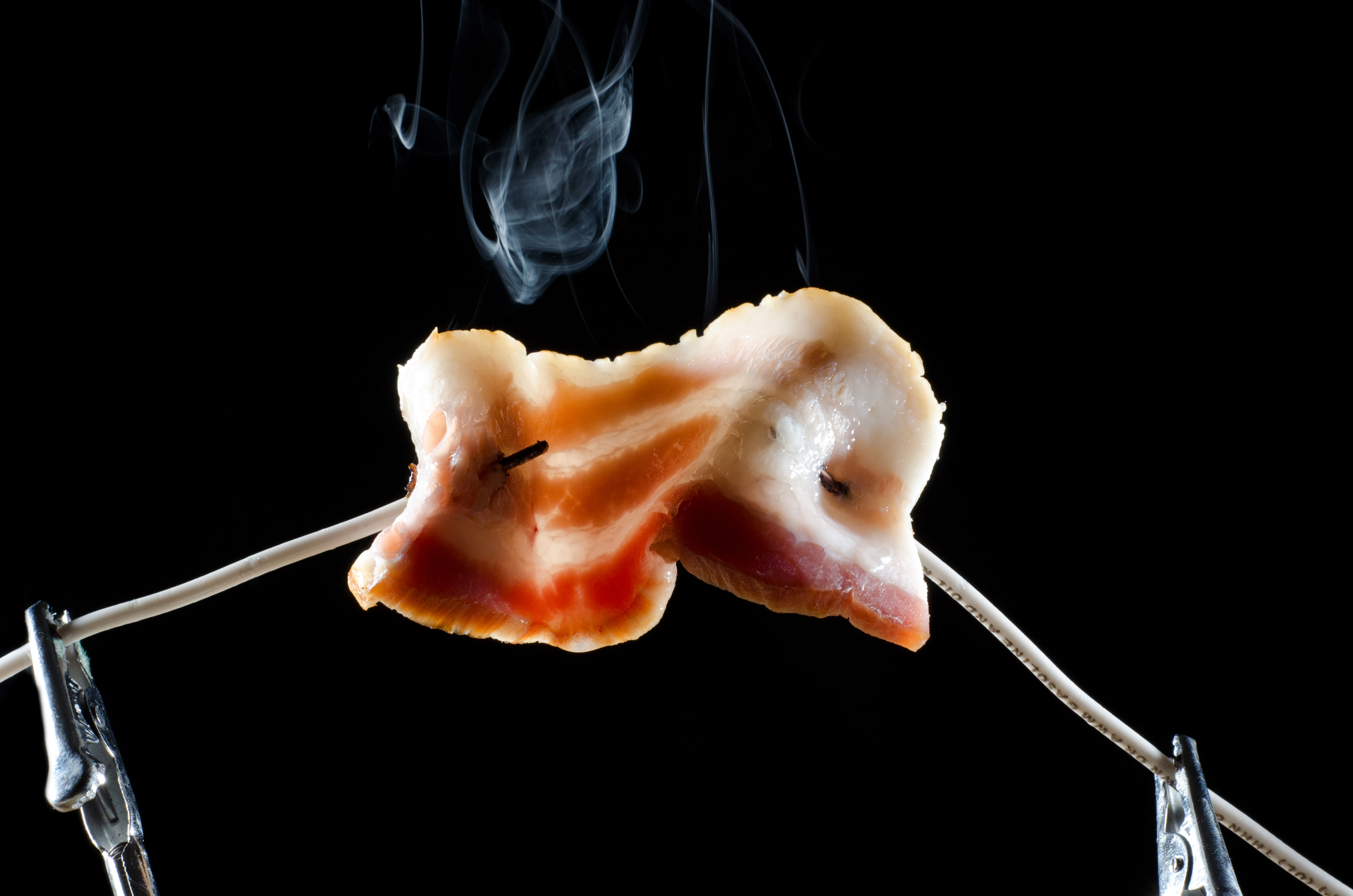
I love sous vide cooking. Those of you who have discovered it know what I’m talking about – nothing short of a new frontier of culinary technique, and one of the first pure intersections of science and cuisine. However, if you aren’t willing to drop $1000+ (or you don’t have a soldering iron and some patience) it used to be the case that you were excluded from the inner circle of sous vide wizardry. Professional thermal immersion circulators are extremely expensive and, due to their scientific design aesthetic, aren’t very likely to show up on the shelves of Sur La Table anytime soon. But, for the first time, a home cook willing to spend $450 (the price of a top-of-the-line stand mixer + accessories, for example) can experience for themselves the eye-opening, mouth-watering, religious revelation of their first sous vide steak.
I’ve blathered on for the last handful of posts about how great sous vide is, and to a certain extent, I’ve become obsessed with the method. So, you can imagine my delight when the nice people at SousVide Supreme offered to let me test drive a unit for two weeks (there’s my disclosure). When the unit arrived, I anxiously brought the box inside and began unpacking. The first thing that struck me? “Damn, this thing is big!” So big, in fact, that there was no hope of ever storing a unit like this anywhere in my kitchen. For the entire two week trial run, it sat on top of my stove, next to my stockpot that’s also too big to find a home. If you can’t tell from the picture above, the unit is about the size of a large bread machine. And although it’s handsome enough for what it does, I’m not sure I would acquiesce to the idea of making this behemoth stainless brick an objec d’art atop my precious counter space. That said, I’ve found myself cooking nearly everything sous vide recently, so perhaps it wouldn’t be such an inconvenience to have the machine on display all the time.
Once I got over the size issue (like a blind date with a girl who has “a great personality”), it was time to put this unit through its paces. By now, I had already been cooking with my DIY sous vide machine for a few weeks, so I had some reasonable expectations of heating time, temperature evenness (temperature measured at different spots in the basin) and temperature fluctuation (how well the target temperature holds over time). I filled the unit’s basin with hot water from my kitchen faucet to speed up the pre-heating time. If you haven’t been to the gym in a while, you might notice that the water-filled unit is quite heavy. The unit features well-placed inset handles to help with carrying, but even so, it’s a precarious beast when full – especially when full of hot water! It would be great to see a drain valve in version 2, since it’s very difficult to negotiate 30 lbs of 120° water up and into the kitchen sink without spilling everywhere.
The SousVide Supreme comes with a wire food rack (shown in the picture above) which actually does a great job of keeping your food in place and allowing ample circulation. Unfortunately, since the unit doesn’t have circulator of any kind, you’ve gotta rely on convection currents to distribute heat evenly through the basin. I was initially quite concerned that this would result in hot and cold spots (which it does) but the temperature differences were reasonably small – within .5°F as measured with a laser thermometer.
Heating from faucet temperature (about 110°F) to cooking temperature (about 144°F) took about half an hour – a time scale consistent with my DIY machine, and certainly reasonable for anyone who’s ever waited for an oven to preheat. However, I was quite surprised to see the temperature fluctuations of the machine over time. The video below shows 1 hour of cooking time condensed into 2.5 minutes. The target temperature remained fixed at 144°F, and there were no external factors influencing the temperature (eg. I never removed the lid, opened a window, turned on the stove – in fact, I wasn’t even home!). The temperature varies between 142.1°F and 144.5°F, and if you watch closely, you’ll notice that this variation happens in a very cyclical manner. In other words, the machine is programmed to allow a zone of acceptable temperature that is at least 2.4°F wide.
These temperature fluctuations weren’t noticeable on beef short ribs or potatoes, where there is a wider zone of doneness. However, if you’re finicky about your steak, and especially if you’re aiming for the Goldilocks zone on eggs, those temperature swings may make a difference. As you can see in this invaluable guide to sous vide cooking there’s a substantive difference between eggs cooked at 146°F and 148°F.
All in all, however, the SousVide Supreme did a fine job cooking. Plus, I felt completely comfortable leaving the unit unattended to run overnight or while I was away at work. The all-in-one design certainly is convenient, but the machine’s bulk means you’ll have to annex the dining room to find storage. I’m delighted to see the SousVide Supreme bring sous vide cooking into home kitchens for the first time, and very excited at what the future may bring!

You sound like a kid in a candy store. It’s awesome.
That time lapse clip is pretty awesome… how’d you put that together?
By the way… as a fellow foodie/nerd/Microsoftie, I love your blog!
Not sure why yours vacillated so much. Mine varies by no more than a single degree the entire time, usually by ~.5f. Are you leaving the insulating mat on top? I have mine tucked under a cabinet on my counter, which might also cut down on heat loss.
1. Um, use a Nalgene bottle or a pitcher to transfer water to/from the sink?
2. Man, I am truly sorry about your home-rigs. Maybe next gen will be better, anyways!
Sorry for being silent on the replies – for some reason, my comment notifications started getting sent to spam.
@Ben – I shot the video with a Kodak pocket camcorder and used Pinnacle Studio to speed up the frame rate.
@Dave I kept the mat on top and didn’t vary any other environmental conditions. The amount of the fluctuation is probably also dependent on the set point – I’m guessing that a higher set point causes more variation than a lower one.
@brhau – Thanks for the condolences!
Do you think going over 144F by 0.5F is a big deal? I’m thinking that the fluctuations under 144F would not have an effect on the steak/eggs being cooked, but if it fluctuated upwards by 2F than there would be some serious issues with eggs. Thoughts?
@Steve – You’re right. A .5F fluctuation isn’t so bad, but 2F can be a big deal, particularly for eggs.
When you did the time lapse, where you cooking anything, or was the machine empty? The density of the food being cooked could add stability as it approaches the desired cooking temperature. The front display might be indicating the efforts of the machine to maintain a constant water temp. Perhaps the best way to test for temp consistency on this machine would be to use an immersion probe and external thermometer to test the temp stability of the water itself. Your test might just indicate momentary target temps to maintain 144 degrees. The machine is probably not laboratory grade, and for practical home use a lab level of precision may not be necessary. In commercial use, cooking large quantities for consistent results this would be more important, hence the desire for lab grade temp stability. Maybe adding gentle water circulation with a small aquarium pump would lead to less hot/cold spots. BTW, I thought it was an excellent video.
Scott,
I have read your review of the Sous Vide Supreme twice now, and there is hardly any mention of how it performed for you in real life examples. Did you try eggs? I watched the video twice to confirm that the over temperature range was just .5º, and tend to agree that while not desirable to any of us technologically fascinated “Geeks” (after all Sous Vide does appeal to the “techy side” in us), I would imagine it is primarily the upper end of any range swings that are more important to cooking than the under swings (which would have the effect of lengthening cooking times). Do you agree? How did your couple of weeks cooking with the ‘Supreme go? Were you overall satisfied with the dishes you tried, or was the temperature swing range you observed a “deal breaker” as far as your recommendation for or against a newbie purchasing the Sous Vide Supreme?
I ask not because I have a ‘Supreme, but because I am now looking at purchasing (or perhaps building) a Sous Vide cooking apparatus (unified unit or immersion heater). I know your review was originally tested early last year, but perhaps you still have your notes and remember your overall cooking impression.
On another note, I am somewhat suspicious of units the have their sensor thermometer in close proximity to the heating elements. I would suspect that a centrally located thermocouple probe would give a more accurate average water temperature and not be as influenced by the close proximity of the heating element environment (as in your plans).
In any case, thanks for the interest in Sous Vide.
Steve J
This one looks very helpful machine in kitchen. Thanks for sharing wonderful video review.
Pingback: MUI7GLkEnc MUI7GLkEnc